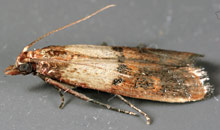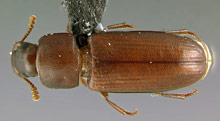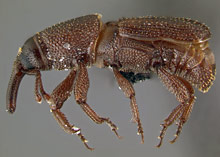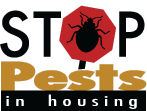Pantry Pests
How to deal with pantry pests
 |
|
Indian meal moth. Photo by Gary Alpert, Env. Health & Safety, Harvard U. |
 |
|
Red flour beetle. Photo by Gary Alpert, Env. Health & Safety, Harvard U. |
 |
|
Rice weevil. Photo by Gary Alpert, Env. Health & Safety, Harvard U. |
Found evidence in recently purchased food? Discard in an airtight garbage bag, then inspect nearby food. If no more appear within the week, you're done. Otherwise:
Throw out or tightly package everything on your shelves. Use heavy-duty resealable bags, tight canisters, or sealed plastic containers. Clear containers make it easier to see emerging pests.
Remove shelf paper, dishes—everything nearby. Vacuum cracks and corners: insect eggs or pupae and scraps of food could be hidden there. Wash with warm water and detergent. Repainting kills the ones you miss. Before restocking, be sure everything is dry.
Got room in the fridge or freezer? Keep pest-prone food there.
Wipe up crumbs and spills as they happen to stay ahead of the game.
What they look like
Several types of beetles and moths can infest boxed foods—pet foods, cereals, pasta and bread, dried fruits, nuts, seeds, and rodenticide bait. Sawtoothed grain beetle, confused flour beetles, red flour beetles, granary weevil, rice or black weevil, drugstore beetles, cigarette beetles, and Indian meal moths are the most common. Small brown beetles or moths near or in boxes of pasta, raisins, pancake mix, dried milk, sugar, cereal, crackers, pet food, birdseed—all tip you off to trouble.
Where they live
Near food, whether in the pantry or your pet's food. See moths or beetles around the house, but can't find larvae in your rice or cereal? They could be feeding off food a mouse stored in your walls.
What they do
They get to your food before you do. Pet food, birdseed, rice, pasta, flour—all could feed them. They're not much of a health threat but they don't add much flavor either.
